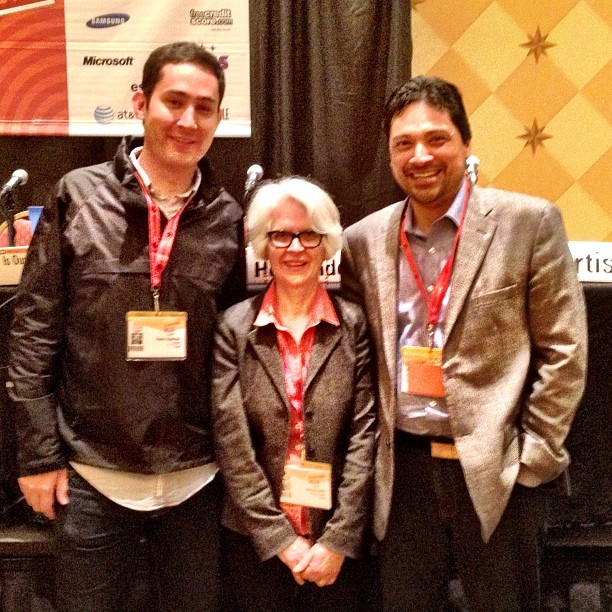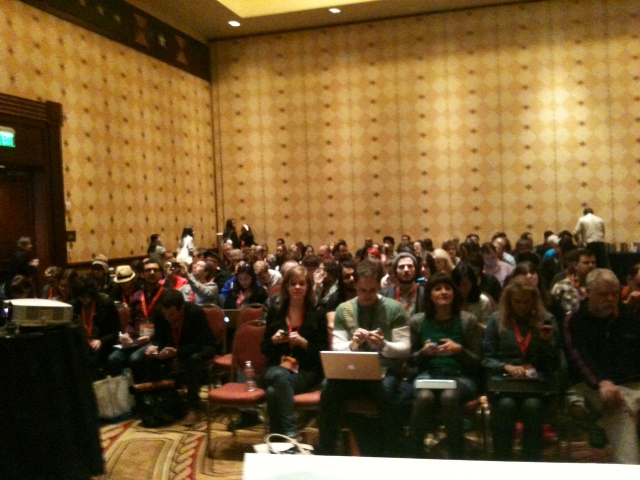
Left to right, the panelists on the Interactive Panel “Is Our Photo Mania Creating Magic or Mediocrity?” at the South by Southwest Conference: Kevin Systrom, Verna Curtis and Richard Koci Hernandez. Photo by Kristen Joy Watts.
I asked my friend Verna Curtis, Senior Curator of Photography at the Library of Congress in Washington, D.C., to write about her experience at the “South by Southwest” Conference in Austin, Texas in early March. A cutting edge gathering, the conference posed important questions for the future of our digital media, and the Library of Congress is obviously taking a pro-active position on the archiving and preservation of our information networks.
« I was a first timer at the quarter century-old spring conference/festival in Austin, TX, known familiarly by young people as “South by Southwest” (run by the company SXSW) (http://sxsw.com/), which started as a music festival. Today more than 30,000 people attend three festivals: music, media, and film rolled into one. The media or “Interactive” portion, which took place from March 9-13, 2012, was a smorgasbord of panels, interviews, solo presentations, group discussions, book readings, mentoring and training workshops.
Kristen Joy Watts, a contributor to Lens (the photography blog at The New York Times) and a content strategist working for the New York agency R/GA, invited me, as the senior photography curator at the Library of Congress in Washington, D.C., to be on her Interactive panel, “Is Our Photo Mania Creating Magic or Mediocrity?” The Library’s involvement in collecting materials “born digital” goes back at least a dozen years to its pilot project in acquiring websites. Since then, websites on such topics as the U. S. national elections, the Iraq War, and the events of September 11th have been archived. In Spring 2010, Twitter gave the Library all of its tweets since March 2006, from which the Library will post selective content. Watts’ panel included Kevin Systrom, co-founder of the new and wildly popular Instagram app, and Richard Koci Hernandez, an avid Instagram user who teaches about media in the School of Journalism, University of California, Berkeley.
At 9:30 A.M. on that Sunday, after a night of partying on a wet Saturday night, we were surprised to look out at an overflowing crowd of more than 250 people, which was standing room only. The panel’s back-and-forth was lively. Questions we pondered were:
Is the mass adoption of digital photography ushering in an era of greater creativity?
Are we missing out on experiences because we are too busy taking and sharing our photos?
Are features like the “Like” button limiting our emotional responses to photographs?
What are the implications for photojournalists of pictorial newsgathering by cell phone users?
Taking center stage was Instagram, which is less than two years old but which caught on quickly; it reached 100,000 users in its first week of existence. A social media network for photo sharing that interfaces with a variety of networking services, the site now archives hundreds of millions of photographs in The Cloud. As immensely gratifying as it might be for today’s hip photo enthusiasts to filter their daily observations with Instagram’s digital options and then share them with friends, can this justify the long-term existence of their images? If there are 380 billion digital images that exist today, what will their future be? I pointed out that since the introduction of the Kodak camera in the 1880s, the problem of sorting through too many photographs has already existed. Editing or choosing those photos —by camera users, artists, curators and archivists— has been and will be our watchwords.
I was at SXSW unofficially, but Bill LeFurgy represented the Library of Congress as digital initiatives manager for the National Digital Information Infrastructure and Preservation Program (NDIPP). Congress mandated this program to build “a national strategy to collect, preserve and make available significant digital content.” The panel in which Bill took part addressed a provocative topic indeed: “Digital Immortals: Preserving Life Beyond Death.” Acknowledging that it is not possible for institutions to come close to saving all the visual material (or should I say, immaterial) being generated, he called for new approaches. The public will need to preserve their own digital files and the world of libraries will need to advise them how to do so. LeFurgy’s presentation made it clear that the Library of Congress has already begun the task for the United States. »
Verna Curtis
© Verna Curtis 2012
PS : As of April 9, 2012, Facebook purchased Instagram for 1 billion dollars. Begun in October of 2010 by Kevin Systrom and Mike Krieger, employing only 13 people, the company reports that it now has 30 million users who upload 5 million new pictures every day.
